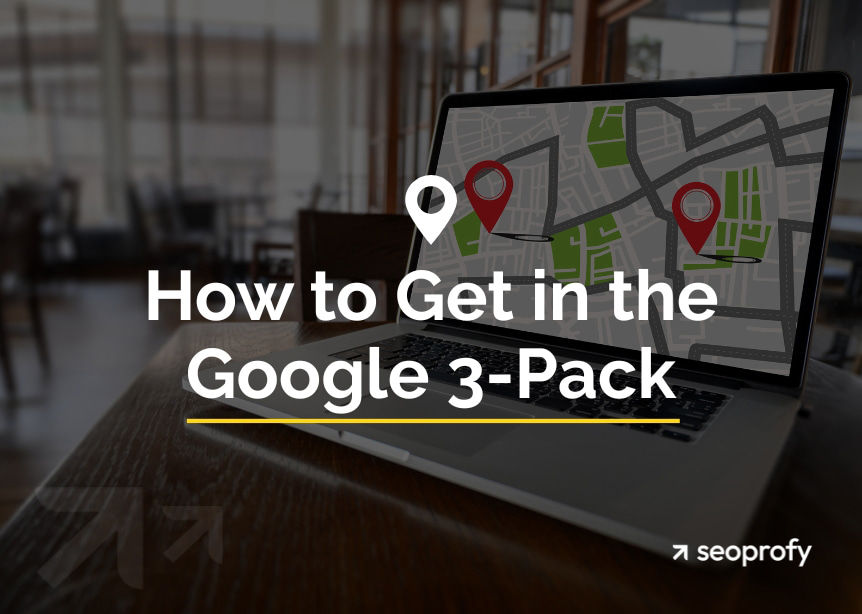Marketplace SEO is the process of improving how products and platforms appear in search results inside online marketplaces. It includes adjusting product titles, descriptions, relevant keywords, and other key elements to fit each marketplace’s search algorithm, while also making sure the marketplace pages are structured in a way that helps them show up in external search engines.
In this article, we explore SEO for marketplace platforms and show how to get your product pages indexed, ranked, and discovered through Google. You’ll see what works in practice and how to adapt classic SEO tactics to the structure of marketplaces.
- Marketplaces have complex structures and vendor-driven content, so classic ecommerce SEO tactics rarely work as-is.
- Fixing architecture first gives Google access to pages that would otherwise stay buried.
- Duplicate content from filters, parameters, and overlapping listings hurts search visibility and confuses crawlers.
- Vendor content needs real-time checks to avoid generic, low-quality pages dragging down performance.
- Category pages drive most of the organic traffic and deserve the same strategic attention as the homepage or blog hubs.
Marketplace SEO: Why It Requires a Different Approach
Marketplace SEO (search engine optimization) requires a different approach because these platforms have complex structures and unique constraints. Most marketplaces are not built with SEO in mind though. Their structure creates technical and content challenges that limit visibility in Google. If you use the same tactics you’d apply with typical ecommerce SEO, you’re likely to miss the mark.
Here are the core issues that affect organic performance on marketplace websites:
- Duplicate content. Identical or near-identical product pages from different vendors compete with each other, which confuses search engines and weakens rankings.
- Faceted navigation. Filtered category pages often generate thousands of low-value URLs that drain crawl budget and create index bloat.
- Vendor-generated content. Product titles and descriptions are often written by sellers with no SEO knowledge, resulting in keyword gaps, poor formatting, and inconsistent metadata.
- Lack of centralized control. Marketplace owners rarely enforce SEO best practices across listings, which makes it hard to maintain quality and relevance at scale.
In the next sections, we’ll walk you through how to fix each of these. You’ll see what to change in the platform, how to improve content from sellers, and how to make sure Google can find and rank the right pages.
Site Architecture for Multi-Vendor SEO
If Google can’t reach your important pages in a few clicks, it may not rank them. That’s why architecture comes first. Before you think about keywords or content, you need to make sure your site is built in a way search engines can understand.
There are two basic models: flat and deep. A flat structure keeps everything important close to the homepage, ideally within three clicks. A deep structure means you have to go through five or six layers to find something. Google crawls like a user. If it takes too many steps to reach a page, that page may be ignored or crawled rarely.
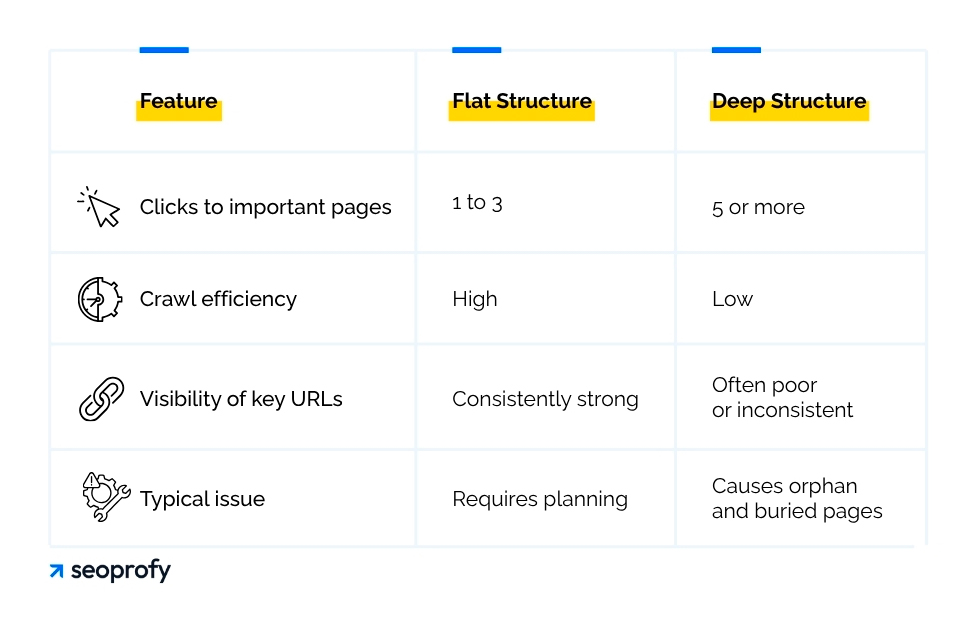
|
Feature |
Flat Structure |
Deep Structure |
| Clicks to important pages | 1 to 3 | 5 or more |
| Crawl efficiency | High | Low |
| Visibility of key URLs | Consistently strong | Often poor or inconsistent |
| Typical issue | Requires planning | Causes orphan and buried pages |
Marketplaces often lean toward deep structures without realizing it. So, important listings end up so far from the homepage that Google doesn’t see them as important.
To avoid that, you need to plan your categories. Group products into tight, focused clusters. Each category should be linked directly from the homepage or top-level menu. Inside each product page, link back to the parent category. Add links to related categories too. This creates a clear, circular structure that crawlers follow easily.
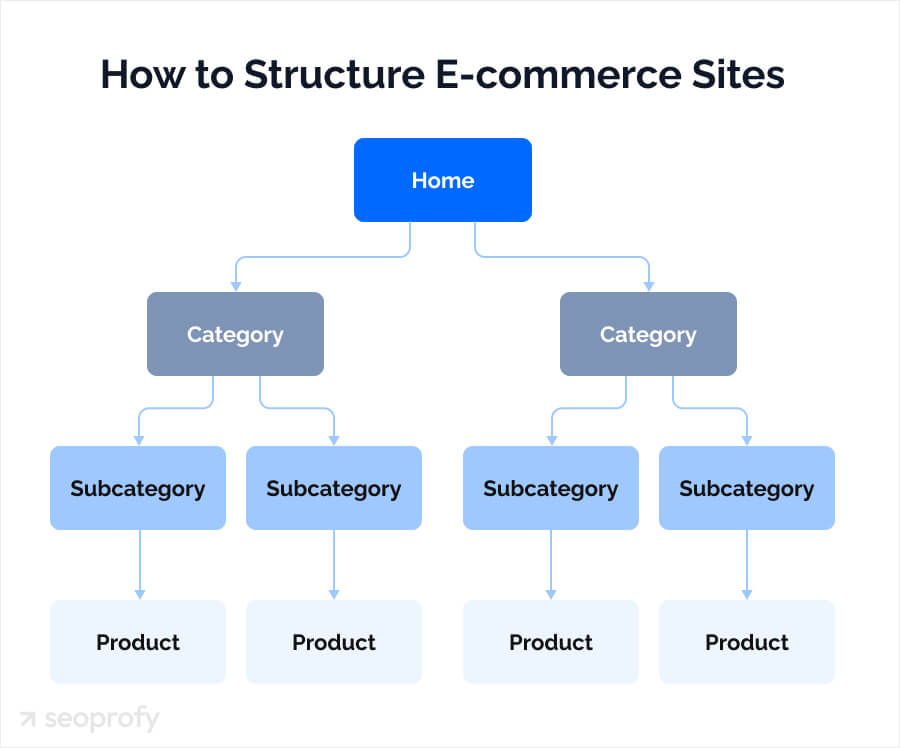
One more thing: watch out for orphan pages. These are pages that exist but have no internal links pointing to them. Google can’t find them unless you explicitly link to them.
To spot them, you can crawl your site with Screaming Frog or Sitebulb, or check Google Search Console for indexed pages (stored in Google’s search database) that are not receiving internal links. Any page that is indexed but not linked from anywhere is probably an orphan. Fix that by linking to it from a relevant category or product.
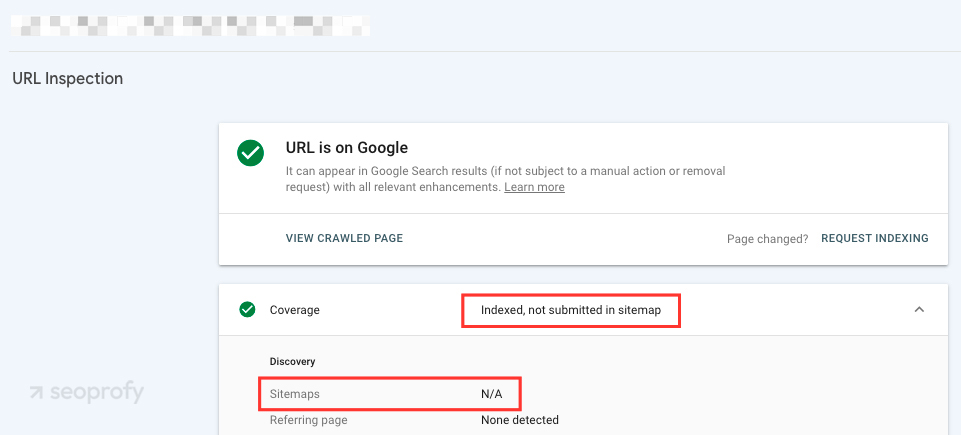
Managing Duplicate Content For Online Marketplace
Duplicate content in marketplaces happens when different URLs show the same or very similar content. Google sees this as a quality issue. It splits relevance signals across competing pages and lowers your chances of ranking. For any effective marketplace SEO strategy, you need a system to detect and manage duplication.
Here are the most common causes:
- Same product listed by multiple vendors. If each seller creates a separate page for the same item, Google finds several versions with near-identical content.
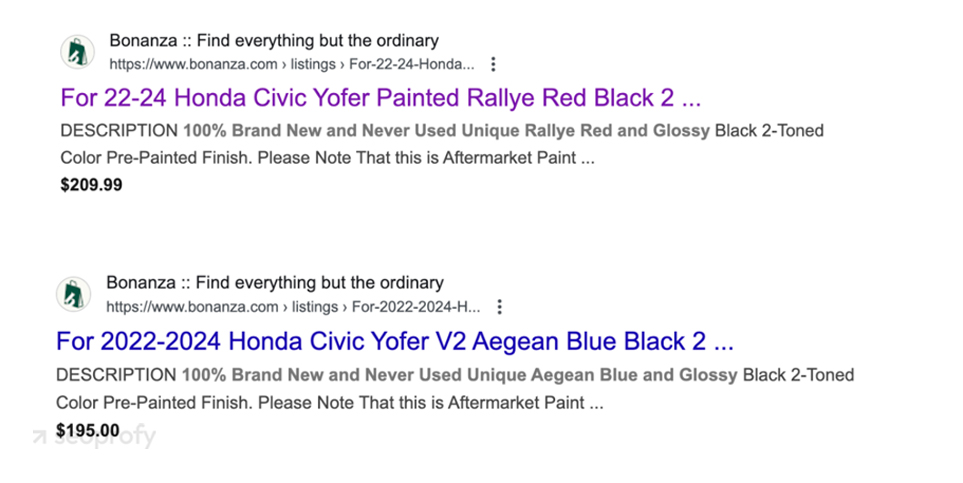
- Filter and sort pages. Faceted navigation creates extra URLs that lead to the same content with slight variations in order or filters.
- URL parameters. Tracking tags and session variables can generate duplicate copies of existing pages, confusing crawlers and diluting authority.
To fix these, you need canonical tags, clean URL structures, and tight control over what gets indexed. That’s exactly what we cover next in detail.
Canonicalization and Noindex Strategy
So, in a marketplace, it’s easy to overload Google with near-duplicate pages. If you don’t give clear instructions, Google decides what to index on its own. And it usually picks wrong. That’s why canonical tags matter!
Use rel=canonical to point all duplicate or variant pages back to one main version. For example, if the same product appears in multiple filtered views or categories, every version should tell Google which one is the original. That way, you keep all ranking signals in one place.
Some pages don’t need to be indexed at all. You can add noindex to things like filtered search results, promo pages, or low-value category variants. These pages still serve users, but they don’t help your marketplace SEO efforts. Let Google crawl them, but keep them out of the index. There are two ways to implement noindex:
- as a <meta> tag
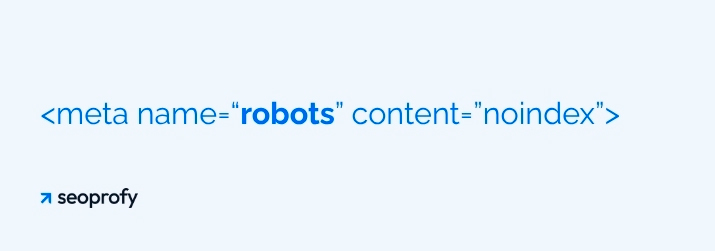
- as an HTTP response header

There is still a common myth in SEO that you shouldn’t use canonical and noindex together. But Google’s own documentation says otherwise. You can apply both when needed, and in a marketplace setup, it often makes sense.
Clean indexing starts with consistent rules. Set them once, test the output in Google Search Console, and monitor what actually gets indexed over time. If noise keeps slipping in, revisit your canonicals and update your noindex rules. This part of your marketplace SEO is never fully done, but it should always be under control.
Vendor Content Guidelines
In a marketplace, vendors create most of the content. That makes your SEO dependent on people who don’t know or care about ranking. If you let them upload anything they want, the result is duplicate listings, keyword gaps, and poor-quality pages that never rank. A strong marketplace SEO strategy starts with clear content rules.
- Set requirements for product descriptions. Ask vendors to describe the product in their own words, not just copy manufacturer specs. Give them a minimum word count and examples of what good content looks like. If needed, review and reject duplicates before they go live.
- Apply the same thinking to images. When multiple listings use the same product photo from the supplier, image search potential disappears. Encourage vendors to upload original photos or let them choose from a shared library with licensed variations.
- Vendor profiles matter too. Force unique descriptions, not just copy-paste bios. These pages often rank for branded queries and help build relevance.
You can’t rely on vendor goodwill. Content must be checked at upload. Add a duplicate checker to your listing form that flags reused text and blocks submission. Use simple text similarity algorithms or API-based tools (like EasyCMT и Utopia Analytics) to detect clones. In high-volume setups, assign content managers to approve listings or run regular audits with scripts that highlight repeated blocks.
One example is Poshmark, a marketplace for secondhand fashion, accessories, and home goods. When similar images or content are detected, their system automatically removes those listings without manual review. Here’s how they presented their automated moderation system:
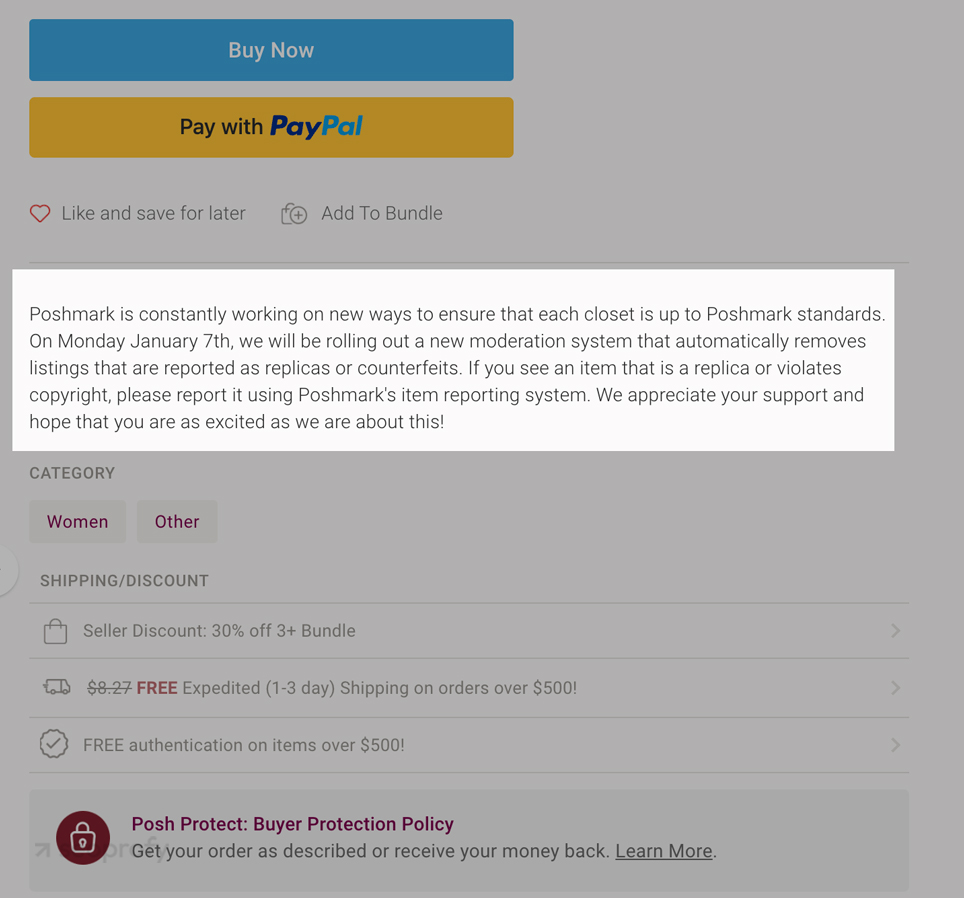
Optimizing Category Pages
Category pages are not just navigation tools. In a marketplace, they are among the most valuable sources of search traffic. These pages can rank for high-volume keywords like “women’s sneakers” or “used DSLR cameras” if they are structured and optimized correctly.
To get there, you need to treat each category page as a standalone landing page. That means adding useful content and signals that help both users and search engines understand what the page is about. Here is what a well-optimized category page should include (with examples from Chairish’s Seating category included):
- Description text. One or two short paragraphs that describe what the category includes, what types of products are available, and how users can navigate the listings.

- Internal links. Link to related categories, top-selling subcategories, and relevant product filters. This helps with both crawl depth and user flow.

- Structured filters. Add filter options with crawl-safe URLs. These help users narrow down results while avoiding crawl traps.
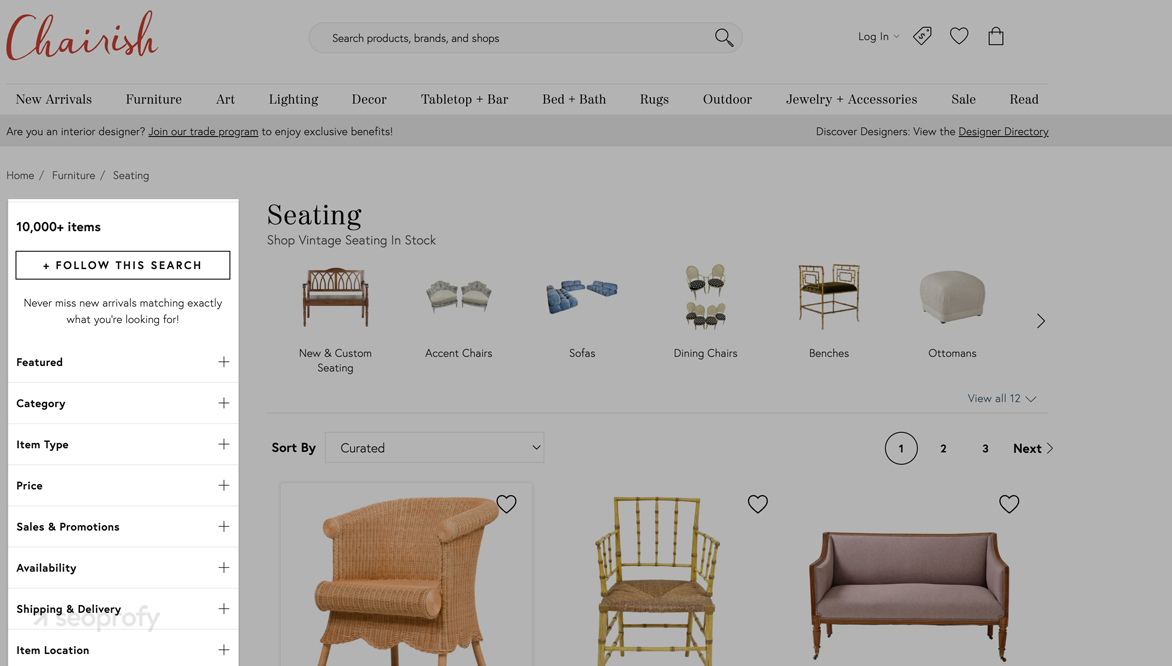
- FAQs. Answer common buyer questions related to the category. This adds semantic relevance and helps the page rank for long-tail queries.
When these elements work together, your category page can hold its own against large retailers in the search results. But to get there, the foundation has to be clean. That starts with avoiding thin pages.
Avoiding Thin Category Pages
In marketplace SEO, category pages with too little content or too few listings are more likely to be ignored by Google. These are called thin pages. They bring in no traffic, dilute your crawl budget, and create noise in the index.
This happens when you create categories before you have enough inventory. For example, a category with only one or two products. There are two ways to fix this:
- Consolidate. If you have multiple small categories with low product volume, merge them into a broader one. This creates a stronger page with more listings and a higher chance of ranking.
- Hide until ready. If a category is part of your long-term strategy but lacks content now, keep it out of the index. Follow the noindex instructions described earlier.
Managing thin pages is part of a marketplace SEO strategy. Your structure should grow with your inventory, not ahead of it.
Product and Vendor On-Page SEO
In marketplace SEO, each product and vendor page is a ranking opportunity. But most marketplaces leave them half-finished. Weak titles, vague descriptions, no structure, and no trust signals add friction for users and confusion for search engines.
Start with the basics. The product title should be clear, specific, and include key attributes that buyers search for. Use model, size, color, condition, or brand. Avoid stuffing keywords. Use the title to signal relevance.
The description should help the buyer make a decision without needing to leave the page. Focus on three things:
- Product specs
- What makes the item different
- Who it’s for
Add calls to action that match the context. On a product page, that could be Buy Now or Ask the Seller. On vendor profiles, direct users to browse listings or send a message.
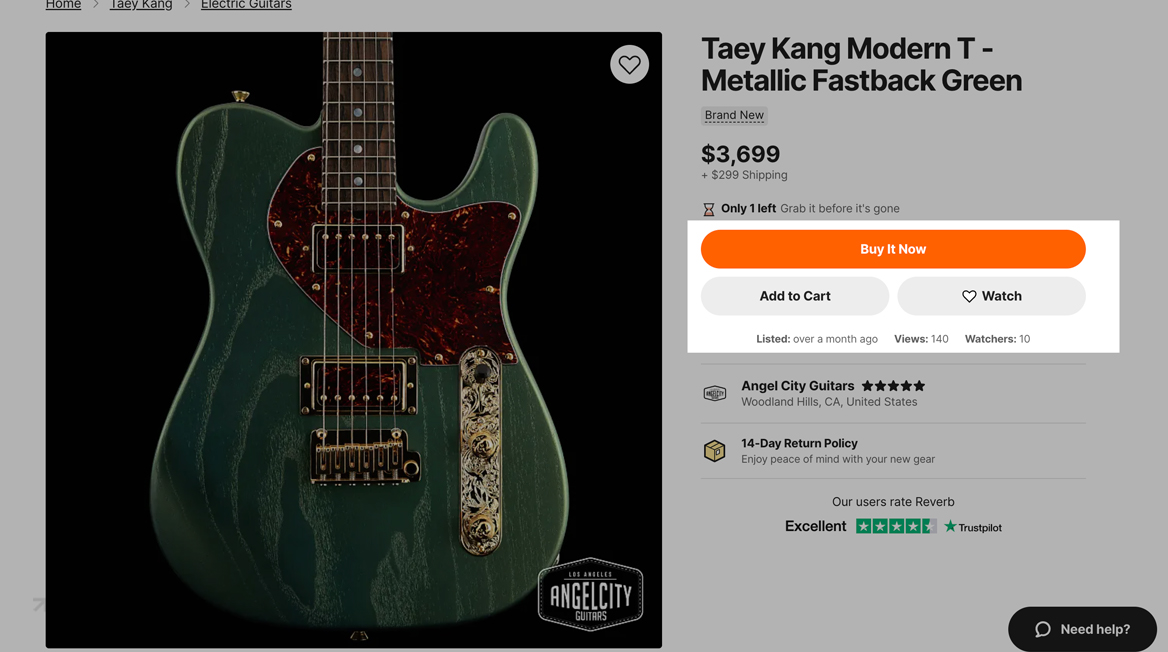
Trust signals are critical. Show seller ratings, reviews, return policies, and clear contact info. These elements increase conversions and help Google evaluate page quality.
For products, enable schema markup (structured data) to help search engines extract key info like price, availability, and review count. You can validate your markup using free Schema.org’s Validator to make sure your snippet qualifies for enhancement in search:
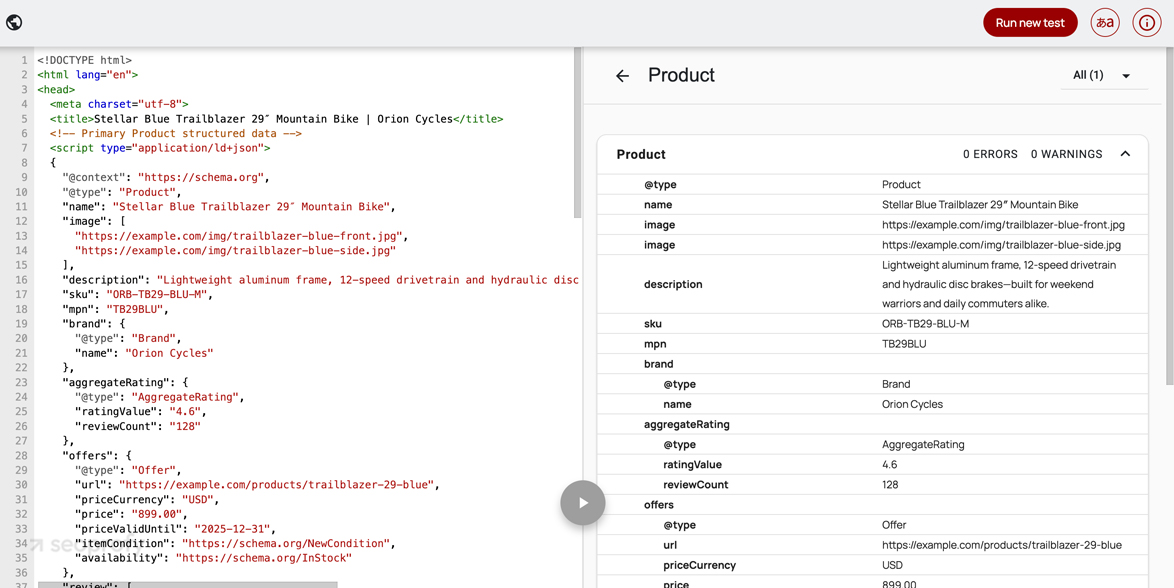
Encourage review generation after purchase. Real feedback adds long-tail keywords, updates the page with fresh content, and builds trust with future buyers.
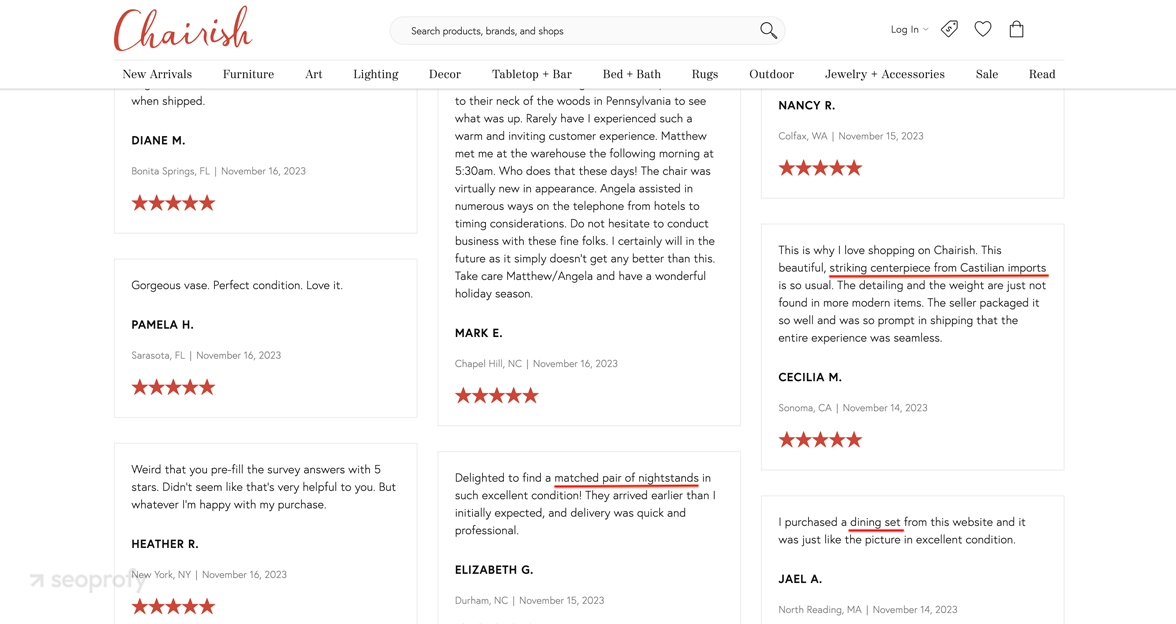
These pages grow with your catalog and contribute directly to your marketplace SEO. When they are structured well, they work as permanent entry points from search.
Content Strategy for Effective Marketplace SEO
Most marketplaces focus only on listings. But if you want to build authority and rank for competitive terms, you need a content layer around your core categories. That means using blog content to support product discovery, internal linking, and long‑tail visibility.
Here’s how to structure a content strategy that actually supports SEO:
- Build topic hubs. For each major category, create a hub page that links to related blog posts, guides, and listings. These act as entry points for informational searches and help search engines understand the relationship between your content and your categories. Here’s how the Reverb marketplace does it:

- Use an editorial calendar. Plan content around seasonal demand and buyer intent. Schedule articles ahead of peaks and use keyword data to prioritize topics with high search volume or clear commercial value.
- Link to categories and listings. Every article should include internal links to relevant categories or product pages. Use descriptive anchors that reinforce topic relevance and help distribute link equity.
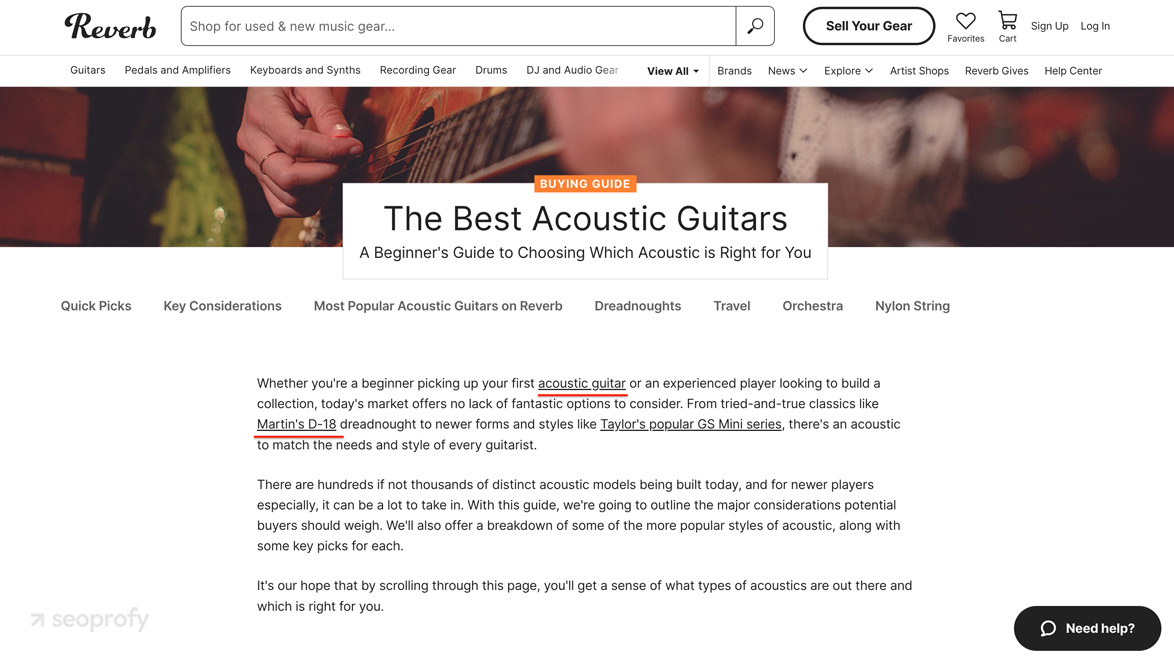
- Create case studies and guides. Use real buyer stories, product comparisons, and tutorials to build trust and add semantic depth. These formats tend to earn backlinks, which is an awesome perk for marketplace SEO.
Link Building for Marketplaces
A lot of marketplaces struggle with link building. Listings change often, vendor pages are transactional, and editorial sites rarely want to link to product grids. That makes traditional SEO outreach much harder to execute.
But links are still critical, since they are one of the top 3 ranking factors. Moreover, they help category pages strengthen domain authority and drive referral traffic. The challenge is to build links to the right pages with the right tactics. Here are three approaches that work in practice:
- Blogger outreach. Instead of promoting individual listings, pitch your platform as a curated source. Reach out to bloggers in your niche and suggest roundups, gift guides, or tutorials that include a link to your category or hub pages. Platforms like Get Blogged help with this directly: they connect brands and marketplaces with relevant bloggers who can feature your site in seasonal gift guides or curated lists.
- Digital PR. Run data-backed campaigns or trend reports that get picked up by news sites. If you have access to internal stats, compile and share them as press-ready insights.
- Partner backlinks. If you work with sellers, suppliers, or brands, offer them something to link to (like a branded vendor page, a showcase collection, or a featured seller interview).
Here’s a real example of how the marketplace eCrater gets backlinks from external sites. The links come from curated lists and product comparisons targeting keywords like “Etsy alternatives.”
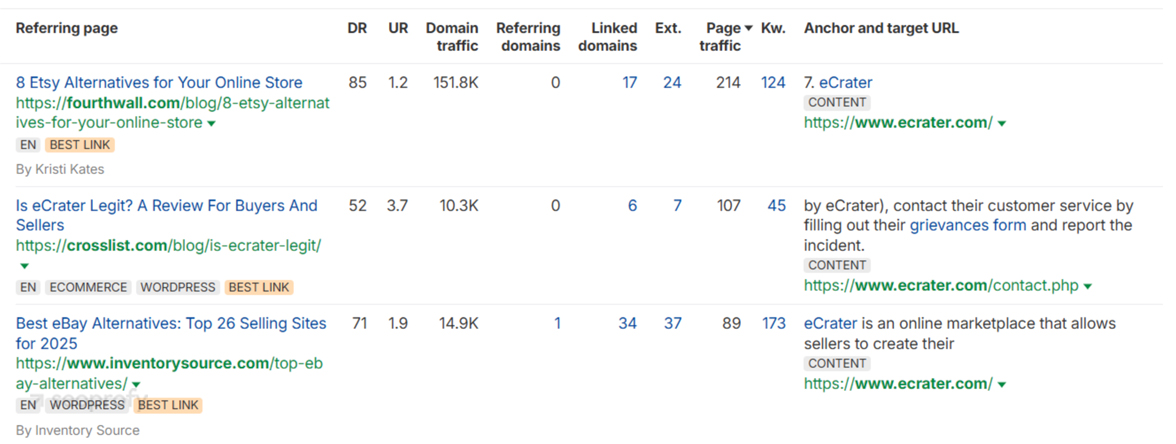
Most of them lead to the homepage or contact page, not product listings. These links last longer and carry more weight.
These tactics take time, but they build link equity that supports your entire structure. That gives lasting value to your marketplace SEO.
Tip: Outreach, digital PR, and partner link campaigns can be overwhelming to manage, even for experienced marketers, let alone marketplace founders juggling dozens of other tasks. A scalable link building service takes that off your plate, letting you focus on growth while SEO specialists handle the heavy lifting.
Linkable Assets for Marketplace SEO
Some pages earn links on their own. These are assets people want to share or reference, especially when they solve a problem or offer something unique. Here are formats that tend to attract links:
- Calculators. Price estimators, shipping cost tools, or ROI calculators for niche categories.
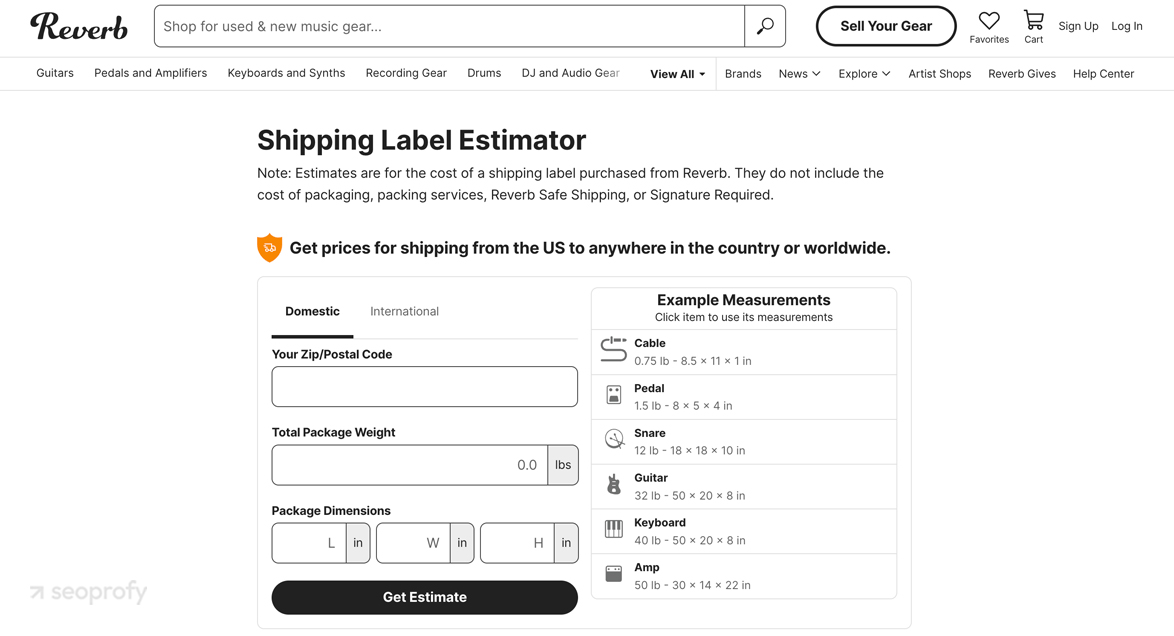
- Comparison tools. Interactive pages that let users compare models, sizes, or sellers.
- Custom search tools. Filters or visual search pages that improve the buyer experience.
- Niche datasets. If your platform tracks trends or pricing data, publish it as downloadable reports or dynamic charts.
These assets support outreach, increase engagement, and bring in backlinks over time. When integrated properly, they boost domain strength and help your marketplace SEO scale with fewer manual campaigns.
Common Marketplace SEO Mistakes to Avoid
Throughout this article, we’ve covered many marketplace SEO problems that come from small things done at scale. One broken rule repeated across thousands of pages is enough to stall growth. For your convenience, we’ve collected the most common issues and how SEO teams handle them in one table:
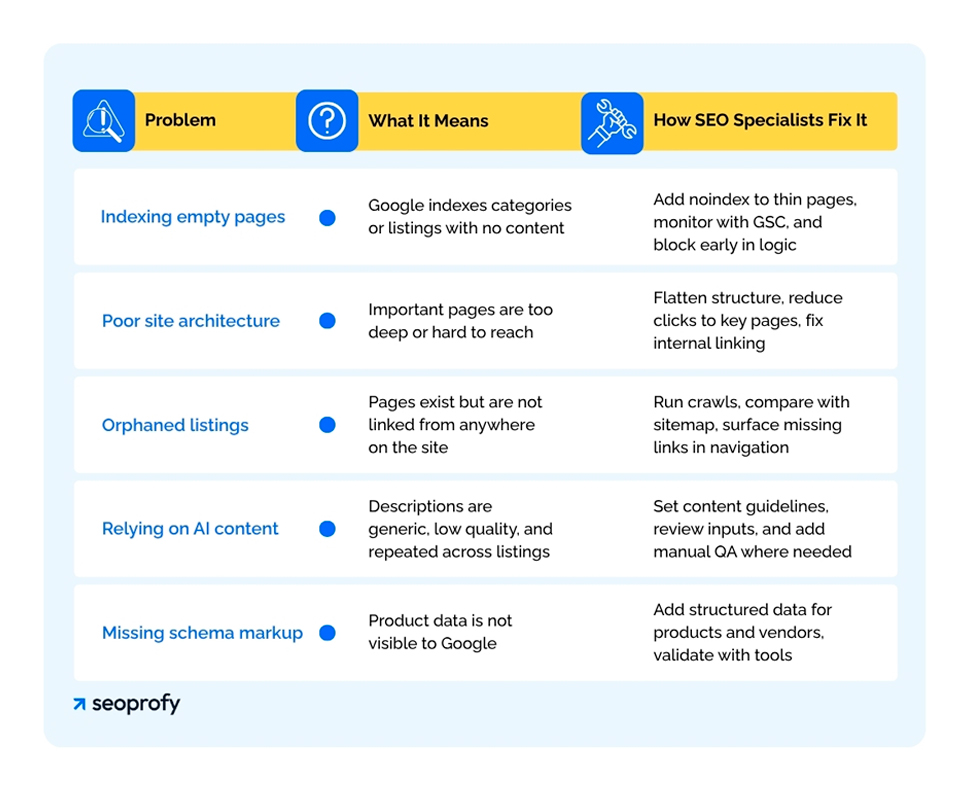
|
Problem |
What It Means |
How SEO Specialists Fix It |
| Indexing empty pages | Google indexes categories or listings with no content | Add noindex to thin pages, monitor with GSC, and block early in logic |
| Poor site architecture | Important pages are too deep or hard to reach | Flatten structure, reduce clicks to key pages, fix internal linking |
| Orphaned listings | Pages exist but are not linked from anywhere on the site | Run crawls, compare with sitemap, surface missing links in navigation |
| Relying on AI content | Descriptions are generic, low quality, and repeated across listings | Set content guidelines, review inputs, and add manual QA where needed |
| Missing schema markup | Product data is not visible to Google | Add structured data for products and vendors, validate with tools |
Final Takeaways: Building a Sustainable SEO Engine
Now you’ve seen how many unique challenges marketplace SEO brings. It’s not like optimizing a single-brand ecommerce store. It’s not like SaaS SEO either, where you can build around one product and scale with content. Marketplaces grow sideways, change daily, and that means your SEO needs to be built for flexibility, clarity, and control from day one.
SeoProfy has worked with marketplaces of different sizes in tough niches. We know how to build systems that survive scale, win categories, and help you compete with massive retailers that own the top of the SERP (search engine results). If you want to see what’s possible with the right strategy, book a free consultation with our team.











